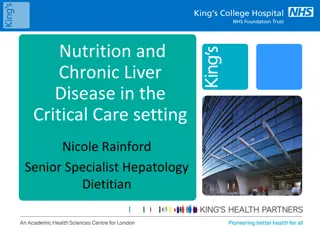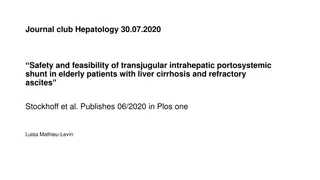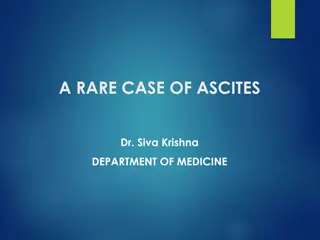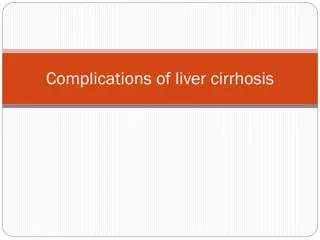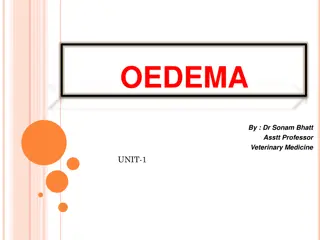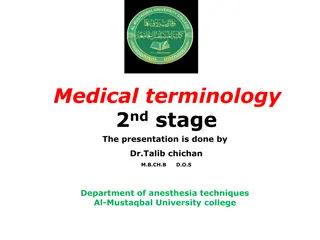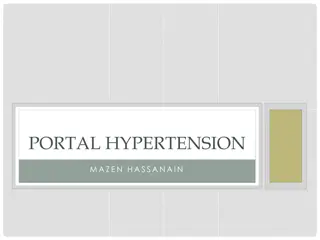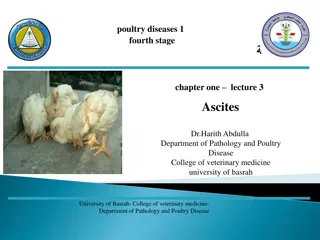Nutritional Considerations for Chronic Liver Disease in Critical Care
Malnutrition is common in chronic liver disease, leading to complications such as ascites and infections. Sarcopenia and weight loss are prevalent regardless of BMI. Critical care patients with liver disease face challenges due to limited physiological reserve, with main causes for ICU admission bei
1 views • 17 slides
Safety and Feasibility of TIPS in Elderly Patients with Liver Cirrhosis
Challenging liver cirrhosis management in elderly patients with refractory ascites has high mortality rates, and transplantation is not always viable. Transjugular intrahepatic portosystemic shunt (TIPS) serves as a non-curative treatment option, aiming to reduce portal hypertension. The procedure i
0 views • 17 slides
A Rare Case of Ascites in a 22-Year-Old Female: Clinical Presentation and Investigations
A 22-year-old female presented with abdominal distension and pain. Her medical history, family history, and personal habits were reviewed. Examination revealed mild hepatomegaly and shifting dullness. Lab investigations showed normal values with no signs of infection. Ascitic fluid analysis indicate
1 views • 20 slides
Understanding Complications of Liver Cirrhosis
Recognize major complications of liver cirrhosis including hepatic failure, portal hypertension, ascites, hepatorenal syndrome, and esophageal varices. Learn about the pathogenetic mechanisms, clinical features, and pathological findings associated with these complications.
0 views • 30 slides
Understanding Complications of Liver Cirrhosis
Learn about the major complications of liver cirrhosis, including portal hypertension, hepatic failure, ascites, spontaneous bacterial peritonitis, and more. Explore the pathogenetic mechanisms, clinical features, and pathological findings associated with these complications, and understand the impa
0 views • 31 slides
Understanding Oedema in Veterinary Medicine
Oedema is the abnormal accumulation of fluid in tissues and cavities, often caused by factors like decreased plasma oncotic pressure, increased hydrostatic pressure, increased capillary permeability, or lymphatic flow obstruction. This article explores the etiology, pathophysiology, and clinical sig
0 views • 17 slides
Differential Diagnosis of Ascites in a 50-Year-Old Man with Liver Disease
Ascites, jaundice, and confusion in a 50-year-old man raise concerns about liver disease. Differential diagnosis includes cirrhosis, malignancy, alcoholic liver disease, and biliary obstruction. Physical examination findings such as spider naevi, hepatomegaly, and asterixis help narrow down the poss
0 views • 45 slides
Management of Malignant Ascites in Advanced Cancer: ESDO Learning
Malignant ascites is a challenging complication of advanced cancer, impacting patient quality of life and survival. Diagnosis involves imaging and cytology, with poor prognostic indicators. Management includes symptom relief with diuretics, paracentesis, and catheter options. Refractory cases presen
0 views • 7 slides
Comprehensive Overview of Medical Terminology in Gastrointestinal System
This content provides a detailed exploration of medical terminology related to the gastrointestinal system. It covers definitions, word roots, combining vowels, suffixes, and prefixes commonly used in this medical field. The material includes information on anatomical terms such as anus, appendix, c
0 views • 18 slides
**Understanding Portal Hypertension: Causes, Symptoms, and Treatment**
Portal hypertension is a serious condition often associated with cirrhosis. Causes include cirrhosis and non-cirrhotic conditions. Symptoms range from asymptomatic to complications like variceal hemorrhage, ascites, and splenomegaly. Preventive measures, such as nonselective beta-blockers, are cruci
0 views • 14 slides
Ascites in Broiler Chickens: Causes, Symptoms, and Management
Ascites is a common disease in broiler chickens, especially at high altitudes. It is characterized by fluid accumulation in the peritoneal cavity or pericardial sac, often containing yellow protein clots. Predisposing factors include reduced ventilation, high altitude, and respiratory disease. Sympt
0 views • 13 slides
